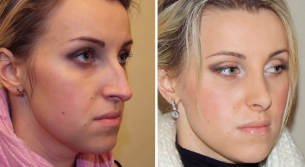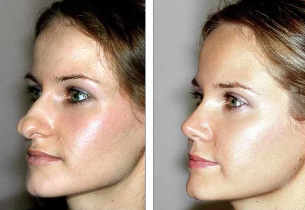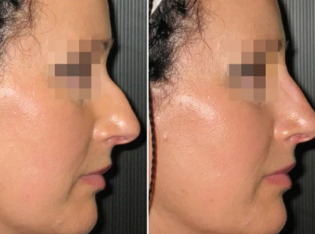Rhinoplasty is one of the most popular types of plastic surgery which involves the manipulation of the area of the nose. The purpose of this procedure is the retrieval of the correct way to the nose, which was broken up as a result of injury, disease, or defect of conditions.
The history of the development of the

You may think that the parent is a recent invention, and the use of the services of the surgeons are often some of the stars in the model. It is not like that. The first references to the technique of recuperation of the nose, refers to the length of service. These are the operations that have been carried out in India, 1000 years before the n. e. Indian doctors to rebuild the damaged head, with the skin and the cheeks of the patient.
In Europe the rhinoplasty was first developed in the Middle ages. The Italian surgeons have described a method of recreation and the way the nose on the skin of the face. In the late 19th century, this type of operations is a new development, thanks to the efforts of the English and German physicians. New techniques, based on the experience of the surgeons at the center.
At first, the assignment of the rhinoplasty was to repair the nose, the beauty, and the aesthetic factors have gained in importance at the end of the 20th century.
Medical indications for it
Any type of surgery, it can be called a creative process, and it is not an exception. It combines the solution of the problem of the aesthetic with the restoration and preservation of the functions of the body (the normal breathing of the nose).
Therefore, there is a surgery you can pursue as a therapeutic and aesthetic purpose. The best way to do an operation, age 25 to 30 years of age, when the cartilage is fully formed. It is, of course, the ideal age can vary depending on the circumstances of the individual.
Medical indications:
- Violation of nasal breathing, or a complete absence.
- Traumatic injuries, which led to the change, and the deformation of the cartilage and the bone.
- The physiological and compnSatornth the curvature of a nasal partition.
- Inherent curvature or deformity of the nose part.
- Cysts and polyps in the nose.
- The hypertrophy of the nasal conchae.
- Violation of the anatomical structure of the nose, leading to different functional complications and pathological conditions of the state. It can be: - an ear, rineixonpela the ILO, bronchial asthma, snoring, frequent respiratory infections, atrophy, or hypertrophy of the mucous membranes of the nose, difficulty in nasal breathing.
Especially dangerous is a violation of the nasal breathing for the child. It can lead to oxygen deprivation in the brain, where it results in the mental and the physical column vertebralnUW in the development stage. The operation of recovering the respiratory function can be given to anyone under 18 years of age.
The aesthetic indications for rhinoplasty
More than half of the operations of the change in the shape of the nose and is performed for cosmetic reasons. The patients that want to achieve harmony in your appearance. The aesthetics of the signs of a plastic surgery can be broken down into two sub-groups:
- To the point. When the nose is disproportionate to the size of the order.
- Feet. To this category belong, above all, the psychological causes are related to the evaluation of their own appearance. For example, the patient doesn't like a little Gorbynka or galinhasnOost.
The psychological causes are most commonly associated with the professional or social environment. The patient is to appear complex, and intense dissatisfaction with the way it looks.
Aesthetic indications:
- The curvature of a nasal partition.
- Acquired and congenital deformity.
- Diproperzionalns dimensions in relation to the person, if the nose seems to be too big or too small.
- Sadloventh the shape of the nose.
- Gorbynka.
- A very large nose.
- MelopriVLEkaórgãosünth, when the tip of the nose, forked, immersed, up, thickened or sharp.
- An asymmetric nose.
- The correction of the effects of the failure to the parent.
It is important to understand that, as a result of the operation, it is not always possible to obtain a perfect result. In surgery, there are limits, therefore, rinaplástica it should be seen as a correction of an existing form.
Indications and Contra-indications

Before the operation, many patients are advised to visit a psychologist. There are some cases in which the patient has a normal nose with no aesthetic or functional violations. So, the issue is to be decided by the consultant.
The plastic surgeon can produce the special measures for you, and tell you exactly if there is a fault. There are parameters that have been defined for the assessment, such as the shape of the nose, and the harmony of its position on the forehead, the eyes, the mouth, the chin, the ears. With the consultation of a doctor can also be simulated on the computer that is supposed to look like after the procedure.
Contra-indications:
- Age-based restrictions. This is not A good idea to run the 18 and 40 years of age. These constraints can be removed because of some objective reasons.
- Diabetes mellitus, or kidney disease, the liver, and the cardiovascular system.
- Folliculitis and / or acne on the nose.
- The violation of the coagulation of the blood.
- In the oncology setting.
- Of mental illness.
- The length of the period.
Types of rhinoplasty
Depending on the goals that are pursued, and the realization of an intervention of rhinoplasty is divided into several types.
The purpose of rhinoplasty can be one of:
- Reconstructive in nature. This is the recovery of the breaches that occur due to disease, injury, addiction, and intra-uterine.
- Beauty. This is a correction of cosmetic defects.
During the operation can be carried out:
- The increase or decrease of the nose.
- The elimination of GorbynKi.
- Fix sadlovenOh the shapes of the nose, that is, the solution is to be developed further.
- The correction of the shape of the tip of the nose.
- Septoplastike (this is the correction of the nose divider).
- Post-traumatic reconstruction.
According to the method of the surgical operation, can be opened and closed. The closed method is used when the aesthetics of the operations, as well as it is, the less traumaticen. In this case, all of the incisions are made inside the nasal cavity. The skin is then separated from the cartilage, the surgeon can easily change the way you work with bone and cartilage with a damp cloth, wipe off the excess, or to be constructed, with the help of implants. After the manipulation of the courts to carefully to be closed.
An open rhinoplasty is intended to apply in more complex cases, for the correction of a great deal of change and of the implementation of the higher volume of transactions. The incision is performed at the skin crease between the wings of the nose. In this case, the surgeon gets access to the tissues, cartilage, and bone. The cure by this method takes much more time than remains in the post-operative period the gut.
Non-surgical rhinoplasty
Non-surgical procedure is an alternative to surgery. However, there are methods to correct for the small gaps.
Rhinoplasty in with the detectives (especially the cosmetic gel) to adjust for minor imperfections, to smooth out the rough edges, to restore the symmetry by changing the shape of the cutting edge. The application of the enchedor allows you to disguise yourself a little. in the collision, to remove the concave, rounded at the tip.
The recovery period after this becomes easy, and the price of the procedure is lower in comparison with the full operation. However, the effect of the enchedor to continue, just a couple of months (maximum 1.5 year). In some cases, at the site of injection is formed on the fibrous fabric, and the outside world, and the effect of this procedure is maintained for years to come. But most likely you will need to repeat the procedure. There is a possibility of complications: a migration of the introduced to the gel, and the change in the structure of the fabric, and when a repeat injection.
With the help of a injection can not only build, but to remove the tissue. There are medications for hormonal replacement basis, which can eliminate all the bumps, lumps, and even, in some cases, the hump. When the introduction of these drugs, it is important to take care of. Often, the procedure is carried out in several stages. 2 to 3 weeks to notice the results.
With the help of twine, you can adjust the shape of the wings of the nose, and even pull at the cutting edge. They are installed strand by a stamping, on the spot, which can form scar tissue. The strands may be broken due to the mobility of the nose. For these reasons, many surgeons rarely resort to such a procedure.

In preparation for the operation
The success of this operation, it is necessary for the interaction with the patient and the doctor. Before the procedure is carried out for the consultation where the surgeon explains to the patient that he was going to achieve the results you want.
Are the studies using the general analysis of blood, and the study of its coagulation, urine analysis, an ELECTROCARDIOGRAM, and testing for HIV, hepatitis and syphilis.
When necessary, we carried out special studies, the picture is taken. If you have a chronic illness, it is necessary for a consultation with a therapist or specialist. The intervention will be postponed in case of an aggravation of chronic diseases, the incidence of reported acute respiratory infection, or infectious lesions of the skin. Prior to the acquisition will be carried out in a conversation with the anesthesiologist.
Your doctor will advise you to leave the alcohol, tobacco, eliminating heavy foods, you can stop taking hypnotics, and sedatives. Two weeks prior to the intervention, you should stop taking aspirin and its analogues.
Complications
The plastic of the nose this is one of the most complex cosmetic procedures, as well as being an important aesthetic and functional part of the face. Complications can arise depending on a number of factors that are 4-15% of patients. They can be divided into the operating and post-operating rooms.
Complications:
- bleeding;
- breaks in the skin;
- the violation of the integrity or the fracture of a bone;
- the deployment of the cartilage flap, and t. d.
Post-operative complications:
- the loss of the sense of smell;
- the loss of, or reduction in the sensitivity of the nose and the lower lip;
- the difficulty of the nasal breathing;
- atrophic rhinitis;
- the deterioration, correct a cosmetic lack, or absence, of any changes;
- psychological complications for the patient does not accept the changes in your appearance, or that he doesn't like the new look);
- swelling of the nose and lower eyelid, inflammation, and suppuration;
- the pigmentation of the skin, and the formation of scar tissue, capillary-loop;
- frequent, or prolonged bleeding from the nose;
- prevent electrical shock.
What is the most dangerous complication that can occur during the course of the rhinoplasty, is a counter-reaction in the event of an allergic reaction to the anesthesia. Anaphylaxis can lead to death in 20% of cases.
The recovery period
The patient can leave the clinic a few hours after the surgery or stay overnight for observation. The major recovery after the correction of the nose, and it lasts for 3 weeks. A full recovery will come in the form of a six-month to one-year.
The seams on drywall longete will be raised by 1.5 weeks. 2 weeks ago, you will not be able to take a hot bath, rinse off with warm water – this can cause bleeding, bruising, or swelling of the face and neck. Need to sleep on the back portion of the reclining. You can't bend, lift weights. In the dust you need to wear a mask.
Over the next three months, you must be carefully in order to be safe from shocks and pressure on the nose, you can't wear goggles, face masks, heavy-duty hats. It is forbidden to make use of the swimming pool and soak up the sun. The surgeon can then establish further restrictions, imposed to the individual, and the condition of the patient.
The results of the operation
The healing of the cartilage and the bone tissue takes several months. The end result was that the surgeon and the patient will be able to examine about 8 months ago. The decision to make the rinoplecomtIV (especially if there are a lot of explicit information) can be seen to enclose negative, and therefore, the patient should be prepared for the ambiguous reaction of their families and friends.
Relatives may be unhappy with the loss of a family or an ethnic face. However, in many cases, the patient himself and his family, you don't notice a particular effect in such a transaction, as well as swelling to hide the changes, and they will gradually come.
Rhinoplasty is able to really change the look and feel, but it's not worth believing, and with the help of cosmetic surgery, you can, with no restrictions on vilepitü all represented in the image. Any operating dangerous thing, it can lead to complications and even worsen the stain. Therefore, we refer to this kind of action seriously and weigh carefully the possible risk and the effect lasts longer.




















